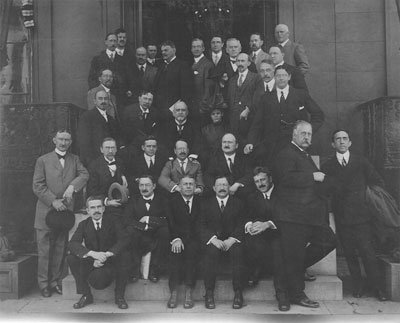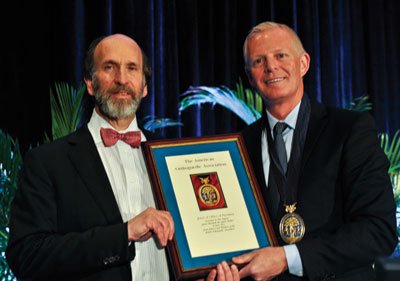The AOA remains dedicated to furthering the art and science of orthopedics
Click Here to Manage Email Alerts
Throughout its 125-year history, the American Orthopaedic Association has been dedicated to identifying, developing and engaging leaders who will advance the art and science of orthopedics.
“[The American Orthopaedic Association (AOA)] is an association dedicated to leadership in the profession of orthopedics,” Douglas R. Dirschl, MD, current AOA president and professor and the chair of orthopedic surgery at University of North Carolina School of Medicine in Chapel Hill, said. “It does not involve itself in lobbying or advocacy. It stays rooted in what is best for the profession and what is best for the patients we serve.”
The idea for the organization was born at a meeting held in the New York City apartment of Newton M. Shaffer, MD, in January 1887, according to A History of the American Orthopaedic Association.
“In the late 19th century, there was deemed a need for an organization of leadership individuals in orthopedic surgery,” Edward N. Hanley Jr., MD, of Carolinas Medical Center, Charlotte, told Orthopedics Today. “Prior to that, orthopedics lacked the organization to further the specialty in medicine.”
The group immediately coordinated its first meeting, that June in New York. A meeting has been held every year since, with the exception of 1945, when it was cancelled because of World War II.

Shown are attendees at the 1910 annual meeting of the American Orthopaedic Association (AOA), held in Washington.
Images: American Orthopaedic Association

Gary E. Friedlaender, MD, 2011 AOA President, is pictured (left) with current AOA president Douglas R. Dirschl, MD, at the 2011 meeting.
Early on, the AOA realized it needed a publication to promote the specialty and disseminate information, Hanley, the AOA historian, said. The group established the American Journal of Orthopaedic Surgery in 1889; they renamed it the Journal of Orthopaedic Surgery in 1919. In 1922, the AOA settled on a permanent name for the journal: the Journal of Bone and Joint Surgery (JBJS).
The AOA spawned other major orthopedic organizations, such as the American Academy of Orthopaedic Surgeons (AAOS) in 1933.
“As the field of orthopedics grew, the AOA was [perceived] as more of an academic institution,” Louis U. Bigliani, MD, professor and chairman of orthopedic surgery at Columbia University in New York, said. “It was clear there needed to be an organization for all orthopedic surgeons.”
Because there was no organization that controlled the quality and skills testing of orthopedic surgeons, AOA members founded the American Board of Orthopaedic Surgeons (ABOS) in 1934.
In addition, an AOA initiative led to the creation of the Orthopaedic Research and Education Foundation in 1963.
International exchange of ideas
The exchange of ideas internationally, through projects like the AOA Traveling Fellowships, has always been important to the AOA.
There are several traveling fellowship programs, including the ABC (American-British-Canadian) Traveling Fellowship, the North American Traveling Fellowship and the Japanese Orthopaedic Association Exchange Traveling Fellowship.
Also the AOA grooms the next generation of orthopedic leaders through the Resident Leadership Forum, which features 2-day meetings for outstanding fourth-year residents from U.S. programs, Kristin Olds Glavin, Esq., AOA executive director, told Orthopedics Today. This program funnels into the Emerging Leaders Program, which offers additional leadership education for developing leaders in their fifth year of residency through the eighth year of clinical practice.
The organization fosters leadership skills through its AOA-Kellogg Leadership Series, launched in 2003.
About 4 years ago, the AOA started the Council of Orthopaedic Residency Directors, a forum in which all orthopedic residency and fellowship program directors discuss challenges and ideas on how to approach them, Terrance D. Peabody, MD, first-president elect of the AOA, said.
Own the Bone
More recently, the AOA played a lead role in several areas, such as the treatment of fragility fractures. There are more than 2 million fragility fractures in the United States annually, Dirschl noted. “Yet population studies indicate only one in five of these patients gets the appropriate evaluation and treatment for their bone disease after their fracture,” he said.
In 2005, the AOA established Own the Bone, a web-based quality improvement program that offers health care facilities the tools to provide patients with fragility fractures with the appropriate evaluation and treatment. Own the Bone has enrolled more than 90 centers in 38 states.
The AOA has taken the lead in improving the flawed fellowship match system. Under the old system, orthopedic residents often felt pressured to select their fellowship direction early in residency training, Glavin explained. Now, “there is an effective fellowship match running in every orthopedic subspecialty,” she told Orthopedics Today.
“[This] has been a tremendous benefit to orthopedic residents,” Peabody, a professor of orthopedic surgery at Northwestern University Feinberg School of Medicine in Chicago, said. “It has improved the professionalism in the selection of orthopedic fellows.”
Orthopaedic Institute of Medicine
The AOA created the Orthopaedic Institute of Medicine (OIOM) several years ago, Dirschl said. Its objective is to offer in-depth and informative reports, and solutions for critical issues.
“It was designed to fill a gap … [and] identify important topics on which we can make a difference,” he said.
The OIOM has examined two areas so far. The first was emergency department call, which had become a nationwide problem that led to challenges in obtaining orthopedic care after hours. The OIOM published a report that contained some solutions and highlighted examples in communities that made strides in resolving the problem.
Most recently, the OIOM has examined relationships between orthopedic surgeons and industry in a report to be published in JBJS.
“Unlike many reports on this topic, which are a list of ‘do nots,’ this report takes a different spin and defines the guiding principles that make for a constructive and positive relationship between physicians and industry,” Dirschl said.
In response to some challenges on direct industry funding of resident and fellowship education, the AOA established the OMeGA Medical Grants Association, a separate, 501c3 organization. Peabody said it allows “industry to sponsor fellowship education but at arm’s length and meeting all legal requirements regarding industry sponsorship of medical education.”
“OMeGA offers a transparent, merit-based, third-party grant system,” Glavin added.
“The concept is that companies can donate and divide up funding in a range of funding categories that basically track the subspecialties and there is residency training,” she said. “That is the extent of their participation in the selection process. They do not select the grant awardees.”
The AOA celebrates its 125th anniversary this year, making it the oldest orthopedic organization in North America.
“The purpose and the mission of the organization have carried it through,” Hanley said. “We have the best and the brightest and most accomplished people in our specialty continuing to give input, suggestions, innovative ideas to promote orthopedics.”
Remaining focused on leadership and the organization’s core strength has also been critical.
“The association has not found it necessary to weave back and forth with the times based on the latest and most popular trend,” Dirschl said. “While there has certainly been change, the core values of the AOA have not changed.”
To continue growing, the AOA must “stimulate leadership in the young orthopedic surgeons that we train,” Bigliani said. “There are academic decisions that have to be made and … we have to be committed to training each new class of orthopedic surgeons in the best possible manner. – by Colleen Owens
References:
- Herndon JH, Buckwalter JA, Simon MA. American Orthopaedic Association: A distinguished tradition. Orthopedics Today. January 1, 2000.
- Urbaniak JR. A History of the American Orthopaedic Association. American Orthopaedic Association. Rosemont, Ill. 2006.
For more information:
- Louis U. Bigliani, MD, can be reached at 622 West 168th Street, PH11-Center, New York, NY; 212-305-5974; email: lub1@columbia.edu.
- Douglas R. Dirschl, MD, can be reached at Carolina Pointe II, 6011 Farrington Road, 2nd Floor, Suite 201, Chapel Hill, NC 27517; 919-966-9072; email: dirschld@med.unc.edu.
- Kristin Olds Glavin, Esq. can be reached at 6300 N. River Road, Suite 505, Rosemont, IL 60018; 847-318-7330; email: glavin@aoassn.org.
- Edward N. Hanley Jr., MD, can be reached at CMC Orthopaedic Surgery, 1025 Morehead Medical Dr., Suite 300, Charlotte, NC 28204; 704-355-5982.
- Terrance D. Peabody, MD, can be reached at NMH/Arkes Family Pavilion, 13th floor, 676 N. Saint Clair, Chicago IL 60611; 312-926-4444; email: tpeabody@nmff.org.
- Disclosures: Bigliani receives institutional royalties through Columbia University from Zimmer. Dirschl, Glavin Hanley and Peabody have no relevant financial disclosures.
